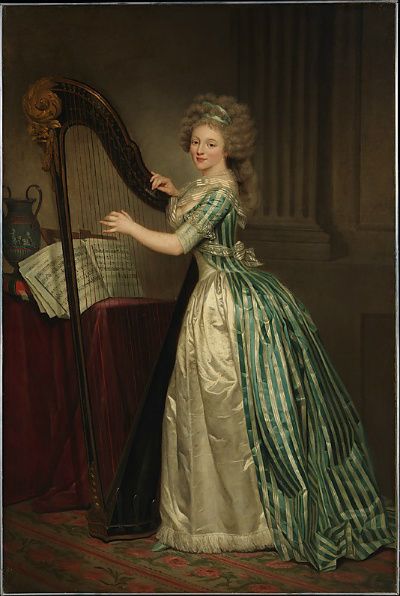Self Portrait With A Harp (Part 5)
3:05 PMPart 1
Part 2
Part 3
Part 4
And here is the conclusion to this study, which I hope you have enjoyed! I had a wonderful time doing this research.

Self Portrait with a Harp, by Rose Adélaïde Ducreux, c. 1791. In the collection of The Metropolitan Museum of Art.
A consideration of the political situation of September 1791 is also important in analyzing Self Portrait with a Harp. Ducreux’s portrait was displayed at a crucial point in the French Revolution. On June 21-25, the royal family attempted to escape from France, but were caught in the small town of Varennes and brought back to Paris in disgrace. This marks a turning point in the attitudes of the Revolution. While at first the people had been willing to work with the monarchy, functioning under the belief of a good king ill advised, and hoping to create a constitutional monarchy, the royal flight disillusioned them. The thought of the King abandoning his country, combined with a letter left by Louis XVI denouncing the Revolution, caused the public to turn against the monarchy.
The flight of the royal family and their subsequent capture ushered in a brief period of paranoia and a previously unseen radicalism. While the National Assembly was working towards a new constitutional monarchy, the French people demanded Louis XVI abdicate the throne completely. On July 17th, a large group gathered at the Champs de Mars to sign a petition demanding the abdication. The situation grew out of control, and the National Guard arrived, attempting to keep the peace. Shots were fired and several people were killed. The Champs de Mars massacre polarized the nation, with some believing it was an act of peace keeping against dangerous radicals, while others believed it was the monarchy attempting to crush the will of the people.
By September 1791, the same month as the Salon of 1791, a new constitution had been completed, creating a constitutional monarchy. Completed on September 3rd and signed by Louis XVI on September 13th, it represented the hope that the monarchy could work together with the people to restore the glory of France. However, by 1792 the Revolution was falling to pieces and the Reign of Terror would begin the most violent and terrifying period of the Revolution. But in the fall of 1791, this threat had not yet materialized. It was a period of wariness, disappointment with the king, but hope that the political turmoil could finally be resolved.
This was the political context in which Ducreux exhibited her painting. France stood on a precipice, engulfed in feelings of wariness and betrayal, yet hope for a more egalitarian future. Ducreux’s painting embodies the dual ideologies present in this period. The luxury of her garments nods to the tradition of the monarchical system, a system the Revolutionaries currently wanted to preserve with modifications, not completely abolish. The neoclassical style points to the new aesthetics and ideas that were emerging, ideas of democracy and equality. Her inclusion of her harp points to an embracing of traditional gender roles, as espoused by late eighteenth-century thinkers. Thus her painting creates a perfect symbol of the times.
Selected Bibliography
Baker, Keith Michael, editor. Readings in Western Civilization: The Old Regime and the French Revolution. Chicago: University of Chicago Press, 1987.
Duncan, Carol. “Happy Mothers and Other New Ideas in French Art.” The Art Bulletin, Vol. 55, No. 4, (1973): 570-583.
Irwin, David G. Neoclassicism. London: Phaidon, 1997.
Koda, Harold, and Andrew Bolton. Dangerous Liaisons: Fashion and Furniture in the Eighteenth Century. New Haven: Yale University Press, 2006.
The Metropolitan Museum of Art, “Self Portrait with a Harp.” http://www.metmuseum.org/Collections/search-the-collections/110000662.
Oppenheimer, Margaret A. “Women Artists in Paris, 1791-1814.” PhD diss., Institute of Fine Arts, New York University, 1996.
Ribeiro, Aileen. The Art of Dress: Fashion in England and France 1750-1820. New Haven: Yale University Press, 1995.
Ribeiro, Aileen. Dress in Eighteenth Century Europe 1715-1789. New Haven: Yale University Press, 2002.
Ribeiro, Aileen. Fashion in the French Revolution. New York: Holmes and Meier, 1988.
Rose Adélaïde Ducreux, Self Portrait with a Harp, Salon of 1791. The Metropolitan Museum of Art, New York.
Sheriff, Mary D. The Exceptional Woman: Elisabeth Vigee-Lebrun and the Cultural Politics of Art. Chicago: University of Chicago Press, 1997.
Shovlin, John. The Political Economy of Virtue: Luxury, Patriotism, and the Origins of the French Revolution. Ithaca: Cornell University Press, 2006.
Tackett, Timothy. When the King Took Flight. Cambridge: Harvard University Press, 2003.
Weber, Caroline. Queen of Fashion: What Marie Antoinette Wore to the Revolution. New York: Henry Holt and Company, 2006.



3 comments